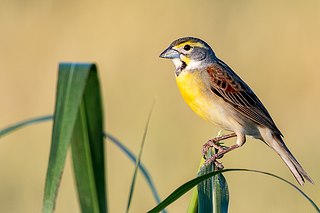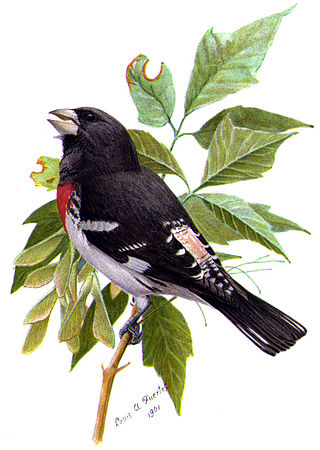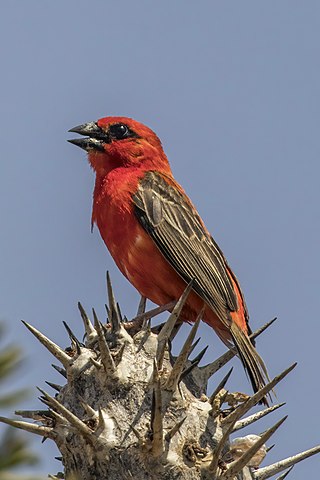
The Philippine creepers or rhabdornises are small passerine birds and form the genus Rhabdornis. They are endemic to the Philippines. They do not migrate, other than to make local movements.

Cardinalidae is a family of New World-endemic passerine birds that consists of cardinals, grosbeaks, and buntings. It also includes several other genera such as the tanager-like Piranga and the warbler-like Granatellus. Membership of this family is not easily defined by a single or even a set of physical characteristics, but instead by molecular work. Among songbirds, they range from average-sized to relatively large, and have stout features, some species with large, heavy bills.

The rose-breasted grosbeak, colloquially called "cut-throat" due to its coloration, is a large, seed-eating grosbeak in the cardinal family (Cardinalidae). It is primarily a foliage gleaner. Males have black heads, wings, backs, and tails, and a bright rose colored patch on their white breast. Males and females exhibit marked sexual dimorphism.

The genus Passerina is a group of birds in the cardinal family (Cardinalidae). Although not directly related to buntings in the family Emberizidae, they are sometimes known as the North American buntings.

Grosbeak is a form taxon containing various species of seed-eating passerine birds with large beaks. Although they all belong to the superfamily Passeroidea, these birds are not part of a natural group but rather a polyphyletic assemblage of distantly related songbirds. Some are cardueline finches in the family Fringillidae, while others are cardinals in the family Cardinalidae; one is a member of the weaver family Ploceidae. The word "grosbeak", first applied in the late 1670s, is a partial translation of the French grosbec, where gros means "large" and bec means "beak".

The blue grosbeak, is a medium-sized North American passerine bird in the cardinal family Cardinalidae. It is mainly migratory, wintering in Central America and breeding in northern Mexico and the southern United States. The male is blue with two brown wing bars. The female is mainly brown with scattered blue feathers on the upperparts and two brown wing bars.

Montifringilla is a genus of passerine birds in the sparrow family Passeridae. It is one of three genera containing the snowfinches. As the English and scientific names suggest, these are high-altitude species, found in the mountain ranges of southern Eurasia, from the Pyrenees east to the Himalayas, Tibet and western China.

Pheucticus is a genus of grosbeaks containing six species.

The red fody, also known as the Madagascar fody in Madagascar, red cardinal fody in Mauritius, or common fody, is a small bird native to Madagascar and introduced to various other islands in the Indian Ocean. It is a common bird within its restricted range, and the International Union for Conservation of Nature has assessed its conservation status as being of "least concern".

Schistochlamys is a genus of Neotropical birds in the tanager family Thraupidae.

Paroaria, the red-headed cardinals or cardinal-tanagers, are a genus of tanagers. They were until recently placed in the family Emberizidae.

Fodies are small passerine birds belonging to the genus Foudia in the weaver family Ploceidae.

The yellow-green grosbeak is a species of grosbeak in the family Cardinalidae.

The yellow-shouldered grosbeak is a species of bird in the tanager family Thraupidae. It is the only member of its genus Parkerthraustes. It is found in Bolivia, Brazil, Colombia, Ecuador, and Peru. Its natural habitat is subtropical or tropical moist lowland forests.

The red-and-black grosbeak is a species of bird in the family Cardinalidae, the cardinals or cardinal grosbeaks. It is found in Brazil, French Guiana, Guyana, Suriname, and Venezuela.

Periporphyrus is a genus of grosbeaks in the cardinal family Cardinalidae.

Amaurospiza is a genus of seed-eating birds in the cardinal family Cardinalidae that are found in Central and South America.

The oriole blackbird is a species of bird in the family Icteridae. Its genus, Gymnomystax, is monotypic. It is a medium-sized yellow and black bird found in Brazil, Colombia, Ecuador, French Guiana, Guyana, Peru, Suriname, and Venezuela, where its natural habitats are subtropical or tropical moist lowland forest, subtropical or tropical moist shrubland, subtropical or tropical seasonally wet or flooded lowland grassland, and swamps.

Chalcomitra is a genus of African sunbirds. Its members are sometimes included in Nectarinia.

Stagonopleura is a genus of small seed-eating birds in the family Estrildidae that are native to Australia.























